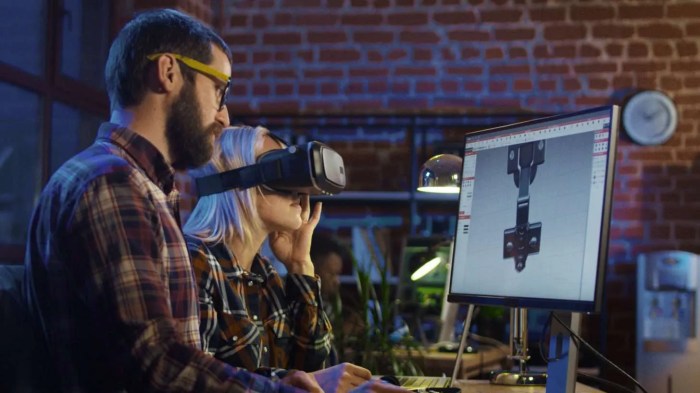Game Developers: It’s way more than just coding and art; it’s about building entire worlds and captivating experiences. This deep dive explores the multifaceted roles within game development, from the pixel-pushing programmers and concept-crafting designers to the marketing wizards who get the game into players’ hands. We’ll cover the tools of the trade, the crazy process of bringing a game to life, and the business side of making millions (or at least, making a living) doing what you love.
We’ll unpack the various career paths, the tech behind the scenes (think Unity, Unreal Engine, and all that jazz), and the ever-evolving landscape of game design. From the initial spark of an idea to the final launch, we’ll examine the challenges and triumphs of creating interactive entertainment. Plus, we’ll peek into the future of gaming and what crazy innovations are on the horizon.
Game Development Tools and Technologies

So, you wanna make games? Awesome! But before you start crafting your masterpiece, you’ll need the right tools. This section covers some of the essential software and technologies that power the game development world, from engines to version control. Think of this as your essential toolkit for building digital worlds.
Game development is a collaborative process, often involving artists, programmers, designers, and producers. Choosing the right tools and establishing a smooth workflow are crucial for success, especially in smaller teams where efficiency is paramount. Let’s dive into the specifics.
Popular Game Engines and Their Key Features
Game engines are the foundational software packages that provide the framework for creating games. They handle things like graphics rendering, physics simulation, sound management, and more. Choosing the right engine depends on your project’s scope, your team’s expertise, and your target platforms.
- Unity: A cross-platform engine known for its ease of use and large community support. Key features include a visual scripting system (Bolt), robust asset store, and support for VR/AR development. It’s a great choice for beginners and smaller teams, and is widely used for mobile, PC, and console games.
- Unreal Engine: A powerful engine favored for its high-fidelity graphics and advanced features. It uses Blueprint, a visual scripting system, and C++ for more complex programming tasks. Unreal Engine is frequently chosen for AAA titles and games requiring photorealistic visuals, but it has a steeper learning curve.
- Godot Engine: A free and open-source engine gaining popularity due to its ease of use and flexibility. It’s a good option for those wanting more control over the engine’s source code and seeking a strong community without the commercial constraints of other engines. It supports 2D and 3D game development.
- GameMaker Studio 2: A user-friendly engine particularly well-suited for 2D games. It boasts a drag-and-drop interface and its own scripting language (GML), making it accessible to beginners while still offering powerful features for experienced developers. It’s a strong contender for indie game development.
The Importance of Version Control Systems
Version control is absolutely essential for any collaborative game development project, no matter the size. It allows multiple developers to work on the same project simultaneously without overwriting each other’s changes, track changes over time, and easily revert to previous versions if necessary. Think of it as insurance for your project.
Git is the industry-standard version control system. It allows for branching, merging, and collaborative workflows. Using a platform like GitHub, GitLab, or Bitbucket to host your repository provides added benefits such as issue tracking, code review tools, and collaboration features.
Hypothetical Workflow for a Small Game Development Team
Let’s imagine a small team of three: a programmer, an artist, and a designer, working on a 2D platformer using Unity. Their workflow might look like this:
- Project Setup: The team creates a Unity project and sets up a Git repository on GitHub. They define clear branching strategies (e.g., main branch for stable builds, feature branches for individual tasks).
- Asset Creation: The artist creates game assets (sprites, animations, sound effects) using software like Photoshop and Audacity. These assets are regularly committed to the Git repository.
- Level Design: The designer uses Unity’s built-in level editor to create game levels, incorporating the artist’s assets. Changes are committed to Git.
- Programming: The programmer implements game mechanics, integrates assets, and writes code using C#. Regular commits to Git ensure code stability and track progress.
- Testing and Iteration: The team conducts regular playtesting sessions, identifying bugs and areas for improvement. Bug fixes and feature additions are implemented using feature branches, tested, and then merged into the main branch.
- Deployment: Once the game is ready, the team builds the game for the target platform (e.g., Windows, macOS, mobile) and deploys it.
Throughout this process, clear communication and regular code reviews are essential to ensure a smooth and efficient workflow. This process isn’t set in stone; it will adapt based on team size, project complexity, and individual preferences. However, the core principles of version control and collaborative development remain crucial for success.
Game Design Principles and Practices

So, we’ve covered the tools and tech, now let’s dive into the heart of game development: the design itself. Creating a compelling game isn’t just about coding; it’s about understanding core principles and applying them creatively to build engaging experiences. We’ll explore key design elements, genre conventions, and even brainstorm a hypothetical game concept to solidify these ideas.Game design is a multifaceted process, blending art, technology, and psychology to create interactive entertainment.
Effective game design hinges on a deep understanding of player psychology, technical limitations, and the chosen genre’s conventions. A successful game balances these elements to create a rewarding and memorable experience for the target audience.
Core Game Design Principles
Successful game design relies on a strong foundation of core principles. These principles guide the creation of engaging and rewarding gameplay experiences. Understanding and applying these principles is crucial for developing games that resonate with players.
- Game Mechanics: These are the rules and systems that govern how the player interacts with the game world. Examples include movement, combat, resource management, and puzzle solving. Well-designed mechanics are intuitive, rewarding, and contribute to the overall gameplay loop.
- Level Design: This encompasses the creation of individual levels or areas within the game. Effective level design considers player flow, pacing, challenge, and visual appeal. It involves careful placement of obstacles, rewards, and points of interest to create a satisfying player journey.
- Narrative Design: This focuses on the story and characters within the game. It involves crafting a compelling narrative, developing believable characters, and integrating the story into the gameplay experience. A strong narrative can significantly enhance player engagement and immersion.
Genre Conventions and Comparisons, Game Developers
Different game genres have established conventions that shape their design. Understanding these conventions is vital for creating games that meet player expectations within a specific genre. Deviation from these conventions can be risky, but it can also lead to innovative and successful games if done thoughtfully.
| Genre | Common Conventions | Example |
|---|---|---|
| First-Person Shooters (FPS) | Fast-paced action, weapon variety, linear or semi-linear level design, emphasis on player skill. | Call of Duty |
| Role-Playing Games (RPG) | Character progression, story-driven narrative, exploration, character customization, often turn-based or real-time combat. | The Witcher 3 |
| Puzzle Games | Problem-solving, logical thinking, often minimal narrative, focus on gameplay mechanics. | Portal 2 |
| Platformers | Precise movement, jumping, obstacle avoidance, level-based progression. | Super Mario Odyssey |
Hypothetical Game Concept: “Chrono-Shift”
Chrono-Shift is a time-traveling puzzle-adventure game targeting a mature audience (18+) who enjoy challenging puzzles and intricate narratives. The game centers around a historian who discovers a device capable of manipulating time. Players navigate various historical periods, solving puzzles that involve altering past events to affect the present.The core mechanic involves manipulating time within localized areas. Players can rewind time to undo mistakes, trigger events, or access areas previously unreachable.
The setting spans several key historical periods, each meticulously researched to create an immersive and historically accurate experience. The narrative is interwoven with the puzzles, unfolding as the player progresses through different eras and unravels the mystery behind the time-manipulation device. The target audience appreciates intellectually stimulating games with a focus on story and puzzle-solving, rather than fast-paced action.
The art style would be realistic, aiming for historical accuracy in character design and environmental details.
The Business of Game Development: Game Developers

So, you’ve built an awesome game. Congratulations! But the hard part isn’t over yet. Getting your game into players’ hands and making it profitable requires a solid understanding of the game development business. This section dives into the different ways games are funded, marketed, and monetized.Game development is a risky business, but with smart planning and execution, it can be incredibly rewarding.
Understanding the different business models and monetization strategies is key to success. The choices you make here will directly impact your game’s design, features, and overall player experience.
Game Monetization Models
Choosing the right monetization model is crucial. Different models appeal to different audiences and require different approaches to game design. A poorly chosen model can severely limit your game’s potential. Three major models dominate the industry:
- Premium: This is the traditional model where players pay a one-time upfront fee to access the complete game. This model often leads to a focus on delivering a polished, complete experience. Examples include games like
-Hades* and
-The Legend of Zelda: Breath of the Wild*, which prioritized a high-quality, complete experience for a single purchase price. - Free-to-Play (F2P): F2P games are free to download and play, but generate revenue through in-app purchases (IAPs), such as cosmetic items, power-ups, or expansions. This model requires careful balancing of gameplay and monetization to avoid feeling exploitative. Games like
-Fortnite* and
-Genshin Impact* are prime examples of successful F2P titles, demonstrating how effective monetization can be woven into engaging gameplay. - Subscription: Subscription models offer players ongoing access to a game or a library of games for a recurring fee. This model often encourages player retention and provides a steady revenue stream. Examples include
-World of Warcraft* and
-Xbox Game Pass*, which both successfully leverage recurring subscriptions to maintain a loyal player base and offer consistent value.
Marketing and Community Building
Even the best game will fail without effective marketing and community engagement. Marketing helps get your game in front of potential players, while community building fosters loyalty and generates organic word-of-mouth marketing.Effective marketing strategies can include social media campaigns, influencer outreach, paid advertising, and public relations. Building a strong community involves actively engaging with players, responding to feedback, and creating opportunities for players to connect with each other.
Think of the passionate communities surrounding games like
- Minecraft* or
- League of Legends* – these communities are a massive part of their long-term success.
Monetization’s Impact on Game Design
The chosen monetization model significantly impacts game design decisions. For example, a premium game might focus on a complete, polished experience with a strong narrative, while a F2P game might incorporate more elements of progression, customization, and potentially repetitive gameplay loops to encourage IAPs.A subscription-based game might emphasize ongoing content updates and a sense of community to keep players engaged over time.
The balance between fun and profit is a constant challenge, and a poorly integrated monetization system can easily ruin even the best game design. For instance, the inclusion of aggressive pay-to-win mechanics in a F2P game can alienate players and harm its long-term success. Conversely, a premium game with limited content might fail to justify its price point.
Expert Answers
What’s the average salary for a game developer?
It varies wildly depending on experience, location, company size, and role. Entry-level positions might start lower, while senior roles can command six-figure salaries.
What kind of education do I need to become a game developer?
A computer science degree is helpful, but not always required. Many successful game developers are self-taught or have degrees in related fields like art or design. Portfolio is key!
Is it hard to break into the game development industry?
It’s competitive, yeah. But building a strong portfolio, networking, and participating in game jams can significantly boost your chances.
What are some essential soft skills for game developers?
Collaboration, communication, problem-solving, and the ability to handle pressure are all super important. It’s a team effort!
